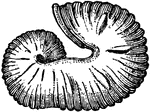Clipart tagged: ‘Genus’

Jasmine
"Botanically Jasminum, a genus of shrubs or climbers constituting the principal part of the natural…

Garden Ranunculus
A large genus of about 600 species of plants, including buttercups and spearworts. They are mostly bright…

Scaphites equalis, Extinct Cephalopod Fossil
Scaphites equalis is a species of extinct cephalopods that thrived during the Cretaceous period. "A…

